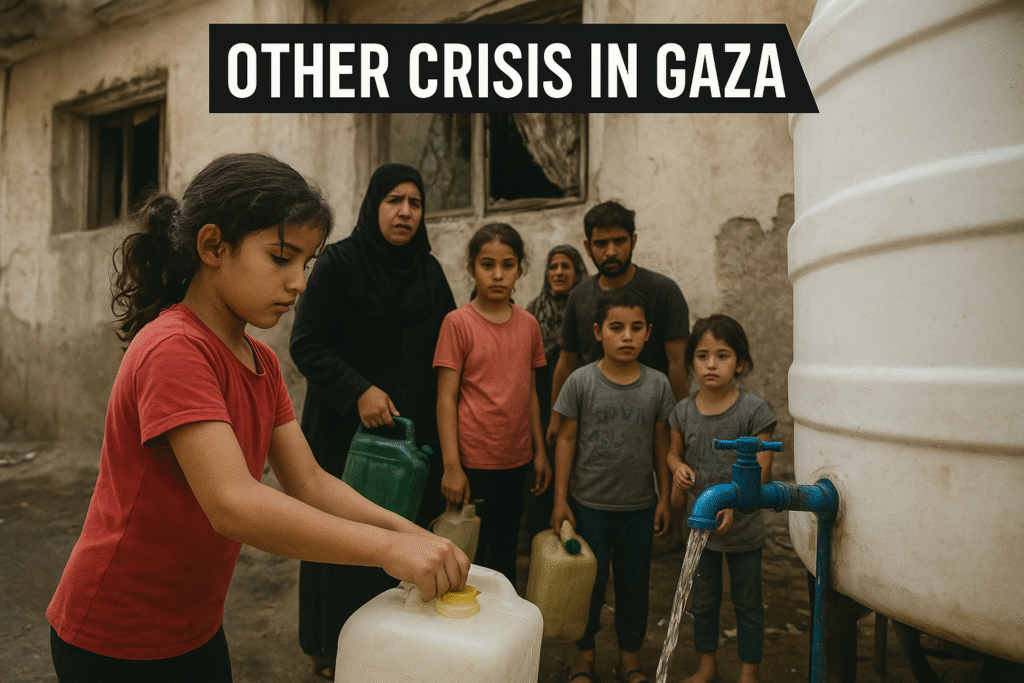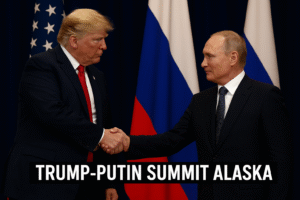Introduction
Other crisis in Gaza is emerging beyond the daily headlines of bombings and political strife. The overlooked emergency is the devastating Gaza water crisis, where families endure dangerous water shortages and rising disease risks. This hidden crisis affects nearly every resident, turning survival into a daily battle. For many, the question is no longer whether they will eat, but whether they will have a clean glass of water to drink.
Also read about Trump-Putin Summit Alaska

1. Background: The Other Crisis in Gaza
The other crisis in Gaza is not just about violence—it is about water. According to the Wall Street Journal, damage to wells, pipelines, and desalination plants, combined with fuel shortages, has crippled Gaza’s ability to provide clean water. Almost every household now faces a shortage that threatens health, safety, and survival.
International observers note that access to safe water is a basic human right under international humanitarian law. Yet, the reality in Gaza shows how quickly this right can vanish under conflict conditions. The crisis is not only humanitarian but also political, as aid groups warn that access to water has become entangled in negotiations and restrictions.
Also know what UN says about Gaza Water Crisis
2. Roots of the Gaza Water Crisis
The Gaza water crisis has deep roots, stretching back decades:
- Destroyed infrastructure: Repeated airstrikes have damaged desalination facilities and pumping stations, leaving once-reliable sources offline.
- Polluted aquifer: Over 90% of groundwater is unfit for human consumption due to contamination from seawater and sewage seepage.
- Fuel and electricity shortages: Without consistent power, purification and distribution systems grind to a halt.
The WHO warns that Gaza’s residents often survive on just 2–3 liters of water per day, compared to the recommended 15 liters minimum. This stark figure illustrates how dire the water shortage in Gaza has become. In wealthier nations, the average per person daily water use exceeds 100 liters, underscoring the disparity.
Water experts caution that the situation is worsening. Salinization of the coastal aquifer is increasing, while climate change adds new stress through irregular rainfall and higher temperatures. Without significant international investment, the region may soon face a point of no return.
3. Health Fallout & Disease Risk Gaza
The disease risk in Gaza is worsening. Lack of clean water leads to outbreaks of cholera-like illness, hepatitis, and diarrhea, especially among children. Hospitals cannot sterilize equipment, maternity wards lack sanitation, and dialysis patients face life-threatening infections.
UNICEF has cautioned that unless immediate interventions are made, preventable waterborne diseases could claim more lives than the conflict itself. Recent surveys suggest that nearly one in four children under the age of five in Gaza shows signs of water-related illness.
Doctors warn that long-term health impacts are equally alarming. Prolonged exposure to contaminated water can cause kidney damage, stunted growth in children, and long-term malnutrition. The crisis is therefore not only immediate but generational.
4. Humanitarian Challenges Gaza: Beyond Water Alone
The humanitarian challenges in Gaza extend far beyond water scarcity. Electricity cuts, food shortages, and hospital collapse multiply risks. Refugee camps, crowded and unsanitary, heighten infection spread. Mothers face the impossible decision of whether to bathe their infants in unsafe water or forego hygiene entirely.
Aid agencies accuse authorities of “weaponizing” humanitarian aid, with unnecessary barriers delaying relief. According to the Associated Press, delays at checkpoints have left shipments of bottled water and water filters stranded for weeks. Relief workers say such obstacles directly worsen civilian suffering.
The crisis also exposes deep inequalities. Wealthier families, though few, can sometimes purchase imported bottled water at inflated prices, while poorer households depend on unsafe supplies. This disparity fuels resentment and underscores the broader humanitarian challenges in Gaza.
5. Daily Life Under the Water Shortage Gaza
Ordinary families live with impossible choices: use scarce water for drinking, cooking, or cleaning. Some resort to collecting rainwater or even seawater despite contamination risks. Parents describe giving their children glasses of water with constant fear of illness.
Children in particular bear the brunt of the water shortage in Gaza. Many arrive at school dehydrated and unable to concentrate. Teachers report higher rates of absenteeism due to stomach-related illnesses. Daily routines revolve around water collection, leaving little time for education or work.
Women often shoulder the burden of managing scarce household water. Hours are spent queuing at municipal taps or waiting for truck deliveries, only to return home with insufficient supplies. The mental stress adds another layer to an already overwhelming crisis.
6. Quotes & Human Testimonies
“We fear the bombs, but we fear the dirty water even more,” said a Gaza father to local reporters.
“Without clean water, even basic surgeries are dangerous,” explained a doctor in Khan Younis.
“Every day I ask myself: should I cook, clean, or give my children something to drink? We cannot do all three,” shared a mother of four.
These testimonies highlight the lived reality of the other crisis in Gaza beyond the statistics. Behind every number is a family making impossible choices.
7. International Response and Solutions
Some steps are underway:
- Egypt is working on a water pipeline to serve 600,000 people daily.
- UNICEF has delivered mobile desalination units to coastal areas.
- NGOs urge depoliticized humanitarian aid to bypass bureaucracy and reach civilians directly.
Experts argue that repairing infrastructure, ensuring fuel access, and creating neutral corridors are essential to solving the Gaza water crisis. Long-term solutions may include investment in solar-powered desalination, regional water-sharing agreements, and international guarantees for fuel deliveries.
However, political obstacles remain. Aid groups warn that unless humanitarian access is guaranteed, technical solutions alone will not solve the crisis. The humanitarian challenges in Gaza are as much about politics as logistics.
8. The Broader Implications
The crisis threatens regional stability. Outbreaks of disease do not respect borders, and withholding water fuels resentment that can prolong conflict. Addressing the humanitarian challenges Gaza faces is not only a humanitarian duty but also a peacebuilding necessity.
If left unresolved, the other crisis in Gaza could accelerate migration from the region as families flee unsafe living conditions. Neighboring countries may face increased refugee flows, straining resources and complicating diplomatic relations.
Global leaders increasingly recognize that water security is tied to security overall. As the Middle East grapples with climate change and rising populations, Gaza’s crisis serves as a warning of what may happen elsewhere if infrastructure and cooperation fail.
9. Outlook & Conclusion
The other crisis in Gaza—its crippling water shortage and rising disease risk—is becoming as deadly as war itself. Unless urgent action is taken to restore infrastructure and secure aid delivery, Gaza risks a humanitarian collapse.
This is not simply a Gaza water crisis; it is a test of international will to protect human dignity. For every day that passes, more children fall ill, more hospitals struggle, and more families lose hope.
The world must act before thirst and disease claim more lives than bombs. Solutions exist, but they require political will, financial investment, and above all, recognition that water is not a privilege but a right.






